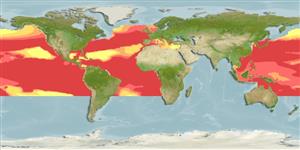Environment: milieu / climate zone / depth range / distribution range
Ecologia
marinhas; oceanódromo (Ref. 51243); intervalo de profundidade 0 - 200 m (Ref. 6517). Subtropical; 60°N - 25°S, 180°W - 180°E
Atlantic, Indian and Pacific: in temperate and tropical waters (Ref. 47377). Western Atlantic: USA and eastern Gulf of Mexico (Ref. 7251). Eastern Atlantic: Bergen, Norway to Madeira and near the Azores, including western Mediterranean; west of Cape Point, South Africa (Ref. 6657). Western Pacific: Japan, Australia, and New Zealand (Ref. 5755). Eastern Pacific: Oregon, USA to Chile (Ref. 2850).
Tamanho / Peso / Idade
Maturity: Lm ? range ? - ? cm
Max length : 200 cm TL macho/indeterminado; (Ref. 9314); common length : 152 cm SL macho/indeterminado; (Ref. 6517); peso máx. Publicado: 150.0 kg (Ref. 47377)
Raios dorsais moles (total): 20; Espinhos anais 0; Raios anais moles: 18; Vértebras: 22. Absence of dorsal and anal spines and of pelvic fins contribute to streamlining of the body, as does the flat and relatively consolidated opercular spines (Ref. 11017, p. 74).
Oceanic and epipelagic; found near surface or in deep water (Ref. 10821). Apparently solitary (Ref. 9314). Feed mainly on jellyfishes, ctenophores, and other gelatinous planktonic animals (Ref. 2850, 6885). Spawning starts at the end of spring and during the summer (Ref. 9314). Juveniles unlike adults in that the median fins are longer and further forward, the mouth toothed and the body and fins black-spotted (Ref. 6517). Rarely found in markets (Ref. 9314).
Life cycle and mating behavior
Maturidade | Reprodução | Desova | Ovos | Fecundidade | Larvas
Tyler, J.C., G.D. Johnson, I. Nakamura and B.B. Collette, 1989. Morphology of Luvarus imperialis (Luvaridae), with a phylogenetic analysis of the Acanthuridae (Pisces). Smithsonian Contributions to Zoology, No. 485. Smithsonian Inst. Press, Washington, D.C. 78 p. (Ref. 11017)
Categoria na Lista Vermelha da IUCN (Ref. 130435)
Ameaça para o homem
Harmless
Utilização humana
Pescarias: pouco comercial
Mais informação
Nomes comunsSinónimosMetabolismoPredadoresEcotoxicologiaReproduçãoMaturidadeDesovaAgregação para desovaFecundidadeOvosDesenvolvimento dos ovos
ReferênciasAquaculturaPerfil para aquaculturaEstirpesGenéticaElectrophoresesHereditariedadeDoençasProcessamentoNutrientsMass conversion
Ferramentas
Relatórios especiais
Descarregue XML
Fontes da internet
Estimates based on models
Preferred temperature (Ref.
123201): 10.1 - 28.2, mean 24.6 °C (based on 1668 cells).
Phylogenetic diversity index (Ref.
82804): PD
50 = 1.5000 [Uniqueness, from 0.5 = low to 2.0 = high].
Bayesian length-weight: a=0.01122 (0.00514 - 0.02450), b=3.04 (2.87 - 3.21), in cm total length, based on all LWR estimates for this body shape (Ref.
93245).
Nível Trófico (Ref.
69278): 3.8 ±0.46 se; based on food items.
Fishing Vulnerability (Ref.
59153): Very high vulnerability (90 of 100).
Nutrients (Ref.
124155): Calcium = 34.8 [20.5, 57.3] mg/100g; Iron = 1.14 [0.70, 1.78] mg/100g; Protein = 19.7 [18.7, 20.6] %; Omega3 = 0.338 [0.212, 0.543] g/100g; Selenium = 37.7 [21.8, 70.6] μg/100g; VitaminA = 6.98 [2.64, 18.68] μg/100g; Zinc = 0.468 [0.336, 0.653] mg/100g (wet weight);
